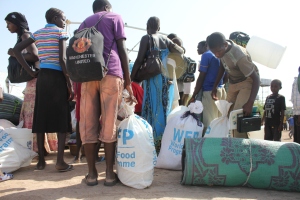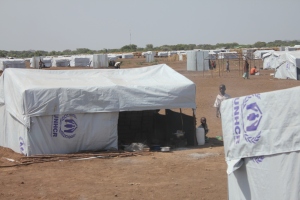The UNHCR Sub-Office at Kakuma continues to receive an influx of new arrivals on daily basis since the first quarter of this year.
During the first quarter of 2013, new arrivals from different nationalities continued to be received into Kakuma. The population kept increasing day by day with predominately South Sudanese new arrivals who were coming in large groups.
Following a referendum in July 2010, South Sudan split from North Sudan, finally gaining independence on 9th July 2011. South Sudan despite being a new young independent nation has not restored peace.
On the 20th March, a group of newcomers arrived in Kakuma after trekking for hundreds of miles from Nyandit village in Jonglei State of South Sudan. The group, led by Peter Lam Chuol, claimed to have been attacked by armed rebels who oppose the Government of South Sudan.
According to interviewees who spoke with Kanere journalists, small groups of South Sudanese have experienced attacks that forced village members to flee for safety. The group trekked through Nadapal close to the Sudan-Kenya border after they were attacked at Walgak village when their cattle were raided. “It’s complicated, the attackers are southerners who are masterminded by David Yau-Yau who is Murle by tribe rebelling against the government of South Sudan,” Peter Lam told Kanere outside UNHCR premises in Kakuma.
Since the beginning of this year, dangerous community attacks by the Yau-Yau militants have been reported in several counties in South Sudan. According to new arrivals interviewed by Kanere, Thol in Nyirol County, Wuror and Dukpadiet have experienced frequent violence. Thousands of the escapees have been forced to separate from their families as they fled from war. On some occasions, the victims have obtained transport assistance from UN Convoys from towns like Pathai to Juba and from Lanken to Bor-town. “I run from Thoi-Lanken, after a month, I was transported to Bor-town by UN vehicle to Juba then from Kapoeta-Nadapal,” Koang Deng told Kanere.
The thousands of southerners fleeing violence have described unforgettable sad experiences. In most cases, the new arrivals explained that several villages were attacked by organized militants, who carried out looting and burning of rural homes. In the worst scenarios, they stated that women are raped, homes looted and children abducted. “My village was attacked in the dead of the night, I was raped; other children were abducted, I managed to escape,” a South Sudanese rape victim told Kanere.
The camp population statistics for the month of April seen by Kanere, show that on the 30th the grand total population was 116,269. Meanwhile UNHCR keeps on receiving new arrivals on a daily basis from other nationalities like North Sudan, Somalia, DRC Congo and Burundi, while refugees from Ethiopia, Rwanda, Eritrea, Uganda, Tanzania and Congo-Brazzaville arrive at weekly or monthly intervals. The camp has also accommodated three Ivoirians, an Iranian, a Zimbabwean and a Cameroonian.

In mid-May the total population in Kakuma stood at 150,891. However, only in less than three weeks more than 5,000 new arrivals were registered and by the end of May, the camp population had increased to 155,269 persons according UNHCR’s official report, despite the fact that continued war and conflict in South Sudan is driving thousands of repatriated Southerners back into this old, horrible refugee city in Kenya.
The new arrivals in Kakuma normally go through registration by the Kenyan Immigration through the Department of Refugee Affairs (DRA), after which new arrivals are transferred to UNHCR for re-registration and issuing of token cards at Kakuma 3 reception center. Since 2006 when the Kenyan government passed its Refugee Act, it was believed that DRA will finally assume the management of refugee camps in Kenya, but this has not yet happened.
In Kakuma refugee camp, the new arrivals have been settled in the far section of Camp 3 settlement after a temporary stay at the UNHCR Reception Center which is currently overflowing. UNHCR’s Field Unit in charge of shelter provision has been finding it hard to shelter large families within the set time frame, a task that is hardly fulfilled.

While the camp situation is equally unconducive to everyone, the new arrivals are in a worse condition – trying to adjust to the camp structure and the way of life that is full of dependency, living under brand new tents labeled ‘UNHCR’. “I can’t bear the high humidity under the tent, it burning my soul, it’s too bright outside, waiting next step in life,” said a Ugandan two weeks old in Kakuma.
In the month of May alone more than 5,000 asylum seekers were registered by UNHCR. Kakuma is already overcrowded due to lack of space. It’s hard to monitor service provision. Indeed, it’s rather a case of survival of the fittest in the context of refugee warehousing.
